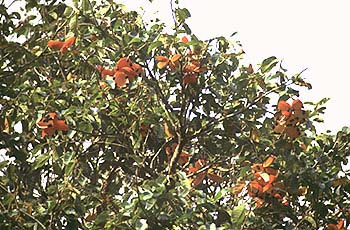| Overview |
| Corner and the durian theory |
| Ashton, Fedorov and evolutionary processes |
| Gentry's hypotheses |
| Applications
• pollination • breeding systems • allozyme analysis • architecture |
| References and further reading |
| Questions |
Such features included
|
 |
Corner's description of the observations which led him to formulate the Durian theory is deceptively simple but developed as he expanded his hypotheses to encompass a greater range of phenomena across the tropics. His ability to link a series of apparently unrelated characters with changes inherent in developmental processes allowed him to successfully project this onto an evolutionary framework.
Why would such obscure features appear in a number of apparently unrelated groups?
Corner postulated that these were ancestral characters, which remained as anomalies in present day forest but which, put into an evolutionary context, could be used to explain the development of complexity and plant diversity in tropical forests.
| This ancestral tree grew from a single axis, as do most
palms today, with terminal leaves and a single terminal inflorescence.
However, this growth form provides little potential for development to
give the variety of form now present in forests. The next evolutionary
development therefore allowed for the production of branches. As
branching systems arose there was an overall reduction in the size of component
parts ie branches, leaves and flowers as the whole plant or tree became
progressively larger.
Increase in size and longevity of such trees, in part due to the removal of the limitations inherent in the possession of terminal inflorescences, meant that diversity of form also increased. This diversity was accompanied by an associated increase in animal diversity, as animals diversified to live in canopy environments as opposed to being ground dwelling, and began to feed on drier and smaller fruits and seeds. |
 |
Over time this ongoing process could give rise to all facets of the complexity seen in the present day tropical forests, and would also explain the changes in plant form required to survive outside the tropics in adjacent seasonal temperate areas.
Although this model cannot be tested it has stimulated much current research into evolutionary mechanisms in the tropics and remains a significant milestone in the study of tropical biology.
NOW TEST your understanding of the basic principles by answering some questions.
